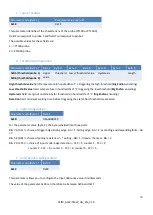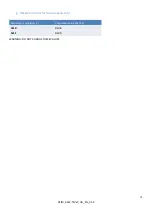
19
ATIM_ACW-TMxP_UG_EN_V1.0
the product transmits these frames both on the Sigfox network and in Local (FSK modulation). The FSK
/ Sigfox repeater then relays these frames on the Sigfox network (The repeater must be placed in a
location where the Sigfox network is accessible).
Important note: If the product has access to the Sigfox network, the default operating mode (Sigfox)
must be used. If this mode is chosen, the product will always send a frame on the Sigfox network
and this same frame in Local mode to the Repeater, which will consume battery unnecessarily.
Product’s clock
Each time you connect to the configurator, the product clock is updated (based on the computer clock) and displayed
(
7
). In addition, an offset in seconds can be applied if needed.
Versions of the product
When connecting to the product, the configurator retrieves all the software versions of the product (product software
and radio module software) as well as the network identifier (
8
).
Temperature probes configuration
On the ACW-TMxP, two temperature probes can be connected and configured (
9
). We find as a parameter:
-
Activation / deactivation of the probe
-
Choice of probe value (PT100 / PT1000)
-
The type of probe wiring (2/4 or 3 wires)
In addition, a threshold detection can be activated on each probe to detect a high or low threshold according to a
configurable hysteresis and duration of overrun. When a measurement reaches a threshold, a radio frame will be sent
(see the
chapter for details on the frame format).
Finally, temperature compensation can be applied to correct measurement errors (
10
) (changes in this compensation
are directly visible on the temperature value which is sent back in real time by the product to the configurator). The
compensation includes two setting points: a temperature offset as well as a multiplying coefficient.
Digital input configuration
The input can be configured according to the following parameters (
11
):
-
The function of the input
: edge detection, counting or deactivation
-
The type of pulling of the line: towards the mass or towards the supply
-
The triggering edge
: rising, falling or both.
In addition, it is possible to set a debounce time which corresponds to the wait after a change of level before taking it
into account ("Input bounce time" in the configurator).
Finally, when the input is configured for edge detection, and only in this mode, the current state of the input is shown
on the right (under "Active level").














































